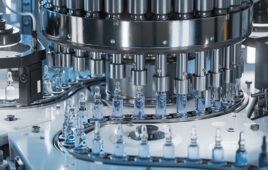
[AI image courtesy of Pixabay]
More AI validation is coming in 2023
Competition is helping drive the field of AI-enabled drug discovery forward. “Over the last five years, the number of AI-native biotech companies has exploded,” Gibson said. While hundreds of companies claim to use AI to find better drugs, many exaggerate their capabilities. “But the sector is maturing, and credibility demands validation,” Gibson said. “In 2023, we’ll see more clinical trial readouts and pre-clinical studies of AI-discovered drugs that will set the bar for what it takes to be taken seriously as leaders in this space.”

Sirj Goswami
The effective use of AI and machine learning will accelerate the drug development process by providing “a more rapid, accurate and deeper understanding of the pharmacologic characteristics of an investigational drug,” said Sirj Goswami, CEO and co-founder of InsightRX. “More ubiquitous use of AI and ML will be accompanied by larger adoption of adaptive trial designs offering greater protocol flexibility that optimizes dosing to improve patient outcomes,” Goswami said.

Chris Gibson
As AI-enabled drug discovery advances, less-capable companies will likely fall by the wayside. Gibson predicted that companies with the savviest data generation capabilities will ultimately prevail. Such companies are “building proprietary datasets with the scale, reliability and relatability needed to take advantage of machine learning technologies to support rigorous science,” he said.
More AI traction will yield more funding
AI can have unintended consequences on biotech, and “that’s a good thing,” said Ashu Singhal, co-founder and president of Benchling.

Ashu Singhal
Singhal notes that the biotech industry is starting to see “real progress with AI-focused drug discovery companies reaching meaningful milestones or readouts of clinical trials.” Relay Therapeutics and Recursion are two examples. “These successful readouts are catalyzing more investment into the space,” Singhal noted. “Big pharma has done $20 billion of AI-based drug discovery deal-making in the last 12 months alone, spending hundreds of millions upfront.”
Singhal believes that the success is driving more partnerships between pharma and AI players. For example, there were 67 partnerships in 2021 and a three-fold increase in the last three years.
“For an industry that has historically prized lone discovery or collaboration around a single molecule, AI is creating a lot of collaboration and partnership surface area in biotech, and it’s also requiring labs to collaborate on massive data sets,” Singhal said.
Organizations push theoretical AI use cases into applied practice
Researchers have thoroughly explored the possibilities of AI-enabled drug discovery to simulate the optimal design of chemical structures and predict their properties. But implementing those concepts in drug discovery remains challenging. “For example, the medicinal chemistry effort required to synthesize a lot of different AI-generated chemical structures is often impractical,” Gibson said. “In 2023 and beyond, we’ll start to see organizations push theoretical use cases of AI into applied practice, which will require incorporating real-world constraints like synthesizability and scalability into AI planning and bringing together experimental processes, modeling and chemical infrastructure,” he added.
Novel machine-learning discoveries require virtuous cycles of atoms and bits
The “digitization” of biotech and general R&D has received considerable attention. “But we’re seeing the limits of in silico experiments to accurately predict biological function,” Gibson said.
Powering machine learning (ML) models with existing scientific literature will only get you so far, Gibson noted. “ML can discover something fundamentally new, but it requires experimentation in the real world,” he added.
Companies poised to drive the most novel discoveries about biology and chemistry will “combine computational simulations and real-world experiments in a tightly integrated iterative cycle of atoms and bits,” Gibson explained.
What biotech needs for AI-enabled drug discovery
To ensure success with AI, biotech needs in-house talent, Singhal said. “The industry is already heading in this direction and is in full-on AI recruitment mode, with a steady state of around 1,500–2,000 AI job openings across large pharma,” he noted.
Additionally, biotech organizations need a data backbone. “Biotech organizations need to start with a solid data and digital infrastructure to enable their AI ambitions,” Singhal said. “Universal access to high-quality data at scale is the cornerstone to a successful AI and ML strategy.”
AI in biotech will be a forcing function for biotechs to accelerate the hiring of data scientists and AI and ML roles and to create better data standardization and more robust digital data backbones, Singhal said. “These changes will not only benefit the application of AI and ML in biotech but will lead to improvements in scalability and efficiency in R&D in general,” he concluded.
Filed Under: Drug Discovery and Development, machine learning and AI





Tell Us What You Think!
You must be logged in to post a comment.